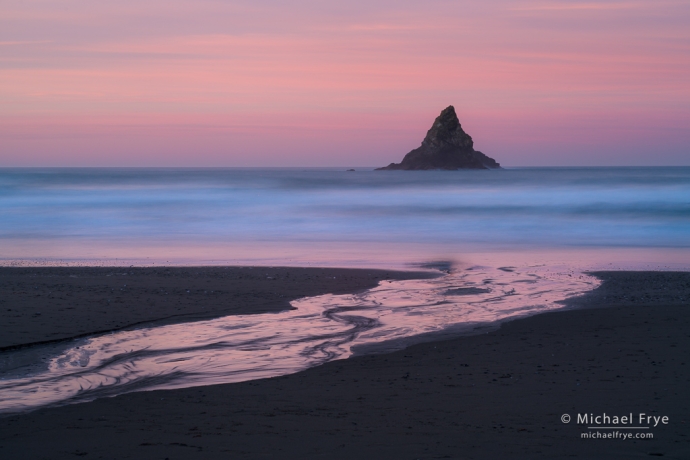
Creek and sea stack, sunrise, Oregon Coast. I used a slow shutter speed (30 seconds) to smooth the waves, which simplified the scene by eliminating texture in the water, and helped create a more ethereal quality to the image.
In one of my posts about Yellowstone last fall I talked about my attraction to dynamic landscapes. And Yellowstone is certainly dynamic, with its ever-changing array of spouting geysers and steaming vents.
But seascapes might be even more dynamic. In addition to the usual variables of landscape photography – light and weather – there’s the ocean itself. Tides, wave height, wave direction, and wind all have big effects on the way a scene looks. And no two waves are the same, so one moment will often look quite different from the next.
That constant motion makes photographing seascapes challenging, but I love the challenge of trying to capture the mood of these ocean scenes – especially the rocky, rugged, windswept coasts of Northern California and Oregon.
Since things are always changing, I try to avoid keeping pre-conceived ideas in my head, and instead adapt to the conditions at hand. What’s interesting and eye-catching at this moment? How can I make a photograph that captures what this place feels like right now?
Light, composition, and timing are always vital. Those three things are probably the most important tools a photographer has for interpreting any scene.
But we can also sometimes use the camera’s controls to vary our interpretation – with a lighter or darker exposure, or selective depth of field, or varying shutter speeds for moving subjects.
That last option – varying shutter speeds – is particularly important with ocean scenes. I carry an array of neutral-density filters along the coast: 4-stop, 7-stop, 10-stop, and 16-stop. These allow me get super-slow shutter speeds even in the brightest light.
But of course I don’t always want a slow shutter speed. Every situation is different, but if the waves are big, and I want to capture some of that power, I’ll usually set a fast shutter speed to freeze a big splash, or series of waves. How fast? That depends of course, but 1/125th of a second at a minimum, and I’d rather use something faster to get really crisp water droplets.
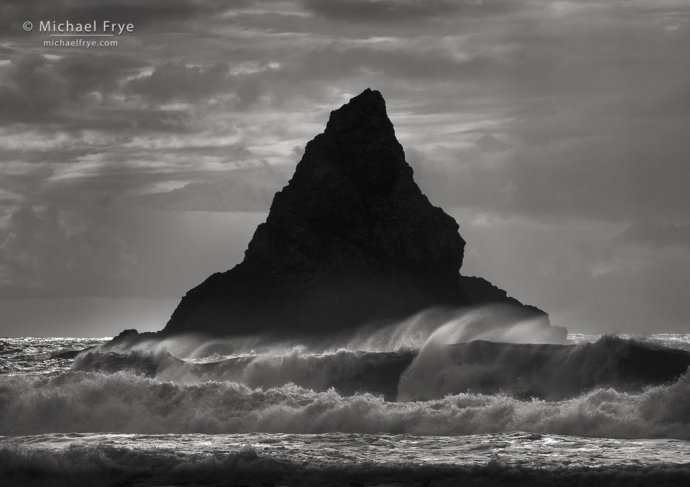
Rock and waves, Oregon Coast. This is the same rock as in the photo above, but it was a different day, with different conditions, and a different mood. An offshore wind was blowing the tops off the waves – one of my favorite conditions. I used a fast shutter speed (1/500 sec.) to freeze the motion and show the texture of the backlit spray.
Even with big waves, however, sometimes a slowish shutter speed – like between 1/4 sec. and 3 seconds – can convey the sense of motion better than a frozen image. It’s tricky though; it often takes the right shutter speed with the right wave to make that work. Here I went even slower, with a 6-second shutter speed timed for a wave splashing over the rock on the left:
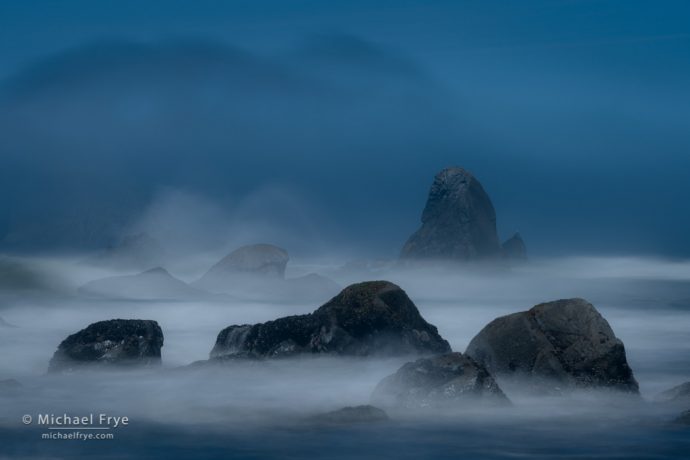
Waves, fog, and sea stacks, northern California coast. Even with some big waves, I wanted a slow shutter speed (6 seconds) to add a more ethereal look to this foggy scene. I tried to time the exposure for a moment when a wave splashed over the rocks on the left.
But if the ocean is calm, and the waves aren’t doing anything interesting, I almost always use a slow shutter speed to smooth out the water. And I mean really slow, like at least 10 seconds. That smoothing effect gives a scene a softer, more ethereal look, and to me often conveys a stronger mood or feeling than a “straight” photograph with small, frozen waves.
Technique is never an end in itself, but rather a tool to enhance your vision. So while it might be helpful to know what shutter speed I used in these photos, I think it’s more important to know the “why,” and I’ve included extended captions to explain the reasoning behind those decisions in these images.
— Michael Frye
P.S. As a reminder, I’ll be conducting another live Lightroom processing demonstration this Saturday at 10:30 a.m. Pacific Time. This session is only open to members of our Education Center, which includes anyone who has purchased one of my Lightroom courses. Find out more here.
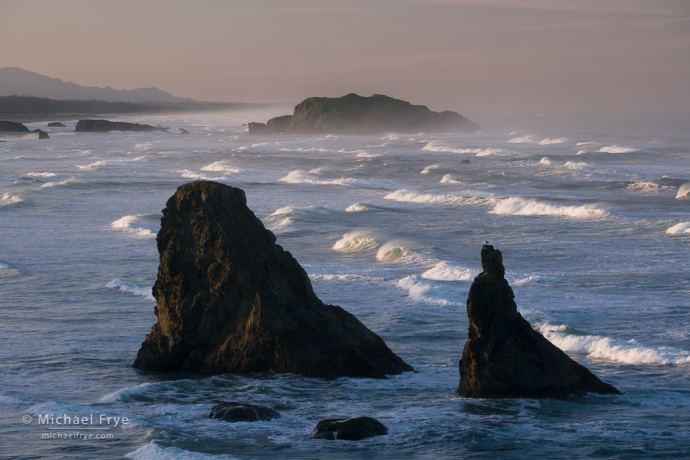
Waves and sea stacks, Oregon Coast. I actually tried a slower shutter speed with this scene, but didn’t like the results. I realized that what attracted me to this view was the repeating patterns of the white, breaking waves, and I needed a fast shutter speed (1/125 sec.) to preserve that pattern.
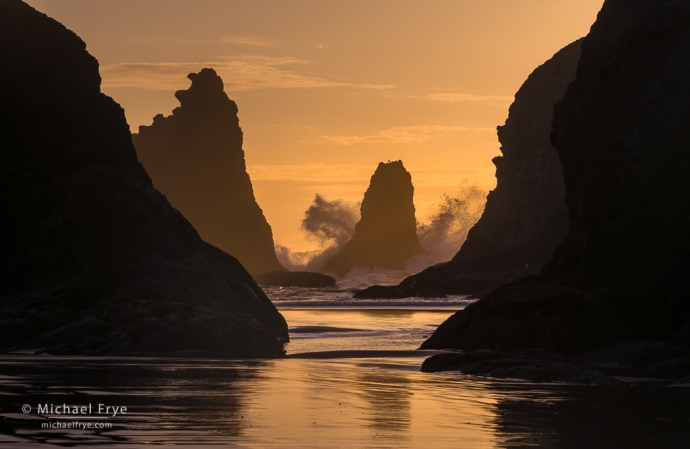
Rock formations, Oregon Coast. I loved the shapes of these rocks, but I thought the scene needed the extra element provided by a big wave splashing against the distant rock, and a fast shutter speed (1/250 sec.) to show the texture and shape of that wave.
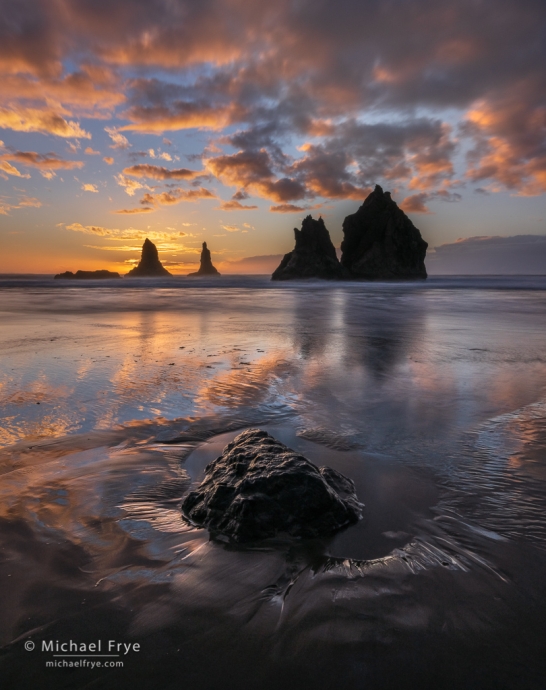
Sunset along the Oregon Coast. Although there were some big waves rolling in during this sunset, the focus of this composition was the sky and the beautiful smooth textures in the foreground, so I used a slow shutter speed (10 seconds) to smooth and soften the waves so that they would recede visually and not attract the eye as much.
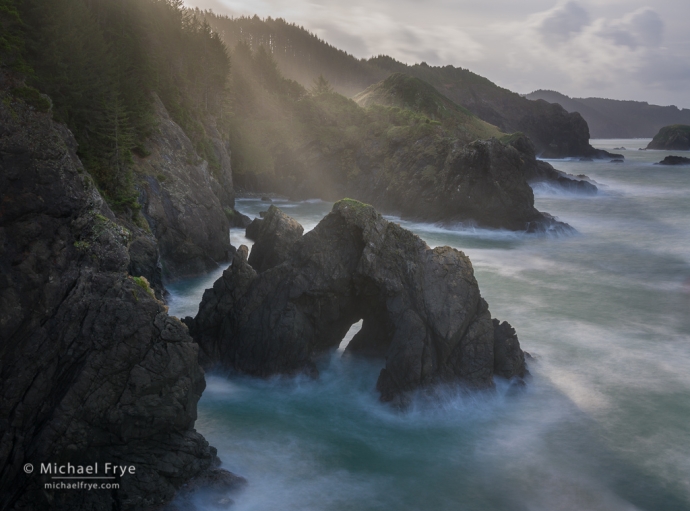
Sunbeams and natural bridge, Oregon Coast. Again, the waves were fairly large at this moment, but in these sheltered coves they weren’t creating big splashes. Besides, I wanted a smoother look to the water to contrast with the rugged rocks, and to add a softer, lighter feeling to the photograph.
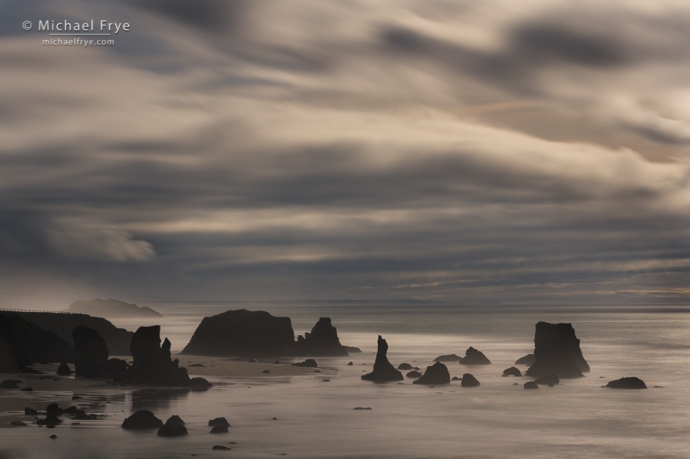
Clouds and sea stacks, Oregon Coast. I was demonstrating how to use a neutral-density filter to get a slow shutter speed to a workshop group, but thought the light and clouds at that moment were wonderful, so to hell with the demonstration, get out your cameras! The shutter speed was 30 seconds, which helped create that soft, ethereal look I like, but in this case also allowed the sea stacks to stand out more clearly by smoothing the water next to them. That long shutter speed also blurred the clouds a bit, which I thought added to the mood in this case. At other times I might prefer to see more texture and detail in the clouds, so I’d have to set a compromise shutter speed, like perhaps 10 seconds or so, to smooth the water as much as possible while still preserving most of the texture in the clouds.
Related Posts: Big Waves; Yellowstone’s Dynamic Landscape; Stretching
Michael Frye is a professional photographer specializing in landscapes and nature. He is the author or principal photographer of The Photographer’s Guide to Yosemite, Yosemite Meditations, Yosemite Meditations for Women, Yosemite Meditations for Adventurers, and Digital Landscape Photography: In the Footsteps of Ansel Adams and the Great Masters. He has also written three eBooks: Light & Land: Landscapes in the Digital Darkroom, Exposure for Outdoor Photography, and Landscapes in Lightroom: The Essential Step-by-Step Guide. Michael has written numerous magazine articles on the art and technique of photography, and his images have been published in over thirty countries around the world. Michael has lived either in or near Yosemite National Park since 1983, currently residing just outside the park in Mariposa, California.









Fabulous images. We were in Oregon last June, just before the hot spell and traveled along the coast as well as inland. Bandon Beach was fantastic. I could have spent a week there, but only got one afternoon. What a magnificent place for photography!
Thanks Art! The Oregon Coast is wonderful.